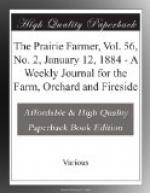A correspondent of Gardening Illustrated (England), says this is the way to make an asparagus bed: Trench the soil at once two spits deep, and work in stable manure as the work proceeds, or if procurable, seaweed and plenty of sand, or any gritty substance, such as road scrapings. It should be left as rough as possible on the surface until April next, when the young plants will be in the best condition for planting, viz., with shoots a few inches long; then draw wide drills, and spread the roots of the plants out, covering with fine sandy soil, leaving the tips of the shoots just peeping through the soil, and if mild showery weather prevails the growth will be rapid. Put some pea-sticks to support the growth and keep it from suffering by wind waving. Merely keeping from weeds is all the other attention required until November, when the old tops may be cut off, and a dressing of rotten manure spread on the surface of the bed, to be lightly forked in during the following spring.
The Rural New Yorker says as follows: We plant the Cuthbert raspberry for late, the Hansel for early—both are of a bright red color, and suitable for market as well as for home use. For a yellow plant the Caroline. It is hardy and productive, though not of the first quality. For canning, or for table use, if you like a fruit full of raspberry flavor though a little tart, Shaffer’s Colossal. It is rather dark in color for market, and perhaps a little soft. For a hardy, early, red raspberry that is sweet and delicious for home use, plant the Turner. For a raspberry that is excellent in every way, plant the new Marlboro. For the earliest and most productive of blackcaps, plant the Souhegan. For a larger and later blackcap, plant the Gregg. For currants, plant the Fay’s Prolific for red, and the White Grape currant for white. For grapes, plant the Lady for earliest white, Moore’s Early and Worden for early black. For later, plant the Victoria or Pocklington, for light colored; the Vergennes, Jefferson. Brighton or Centennial for red, and the Wilder, Herbert or Barry for black. For strawberries, try the Cumberland Triumph, Charles Downing, Sharpless, Manchester (pistillate), Daniel Boone, James Vick, Mount Vernon, Hart’s Minnesota, and Kentucky. You can not select a better list for trial unless by experience you know already what varieties will succeed best on your land.
FLORICULTURE
Gleanings by an Old Florist.
PROPAGATING HOUSES AND OTHER THINGS.
In the days of our boyhood the propagating house was, in the more pretentious nurseries, a very sacred place, under lock and key, and some of its mysteries supposed to be so profound that prying eyes of other establishments were not welcome.




